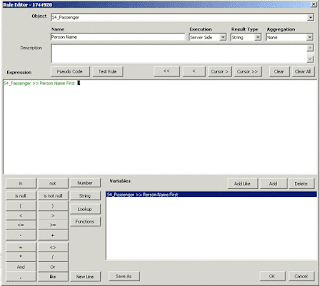What are Reference Lookup Lists?
Lookup
lists are used to populate user interface elements like Lists, Combo box and
Select boxes. When a list is made up of referenced objects, the list is called
reference lookup list. Therefore, this list is implemented only in a reference
relationship.
Example:
Object A refers to object B. In this case, one can view all instances of object
B while sitting on object A using a reference relationship.
Creating a Reference Lookup List
Step
1: Add the reference relationship
Make
sure than an entry for the reference relationship has been made in the
OBJECT_RELATIONSHIP metadata table.
For
example: If the object Ticket refers to object Passenger, the relevant entry
should be made in the OBJECT_RELATIONSHIP table.
Step
2: Make the relationship constrained
Reference
relationship needs to be constrained to refer only to referenced objects that
have the same parent as the referencing object.
For
example: Ticket object should only refer to the passengers that have the same
parent airlines as the ticket.
To
make the relationship constrained, make appropriate entries in the following
columns of the BUSINESS_VARIABLE metadata table:
Reference - Constraint Type: Constrained
Reference - Constraint Object
Type: The
parent object based on which the relationship is constrained. The parent object
must be common to both the referenced and referring object. In this case, the
parent is Airlines.
Reference - Constraint Path: The path to the parent
object that constrains this relationship. The path must begin from the
referencing object type. In this case, the path must begin from ticket and end
with Airlines.
Step 3: Add a label
rule
How
can the reference objects be displayed as a list? A label rule is used to
provide a label to an object instance. Without a label rule, your referenced
objects will not be visible in the list. In this case, the Ticket holder field
on the UI that displays the passenger objects will appear as shown below
without the label rule.
·
Locate
the entry for Object in the OBJECT_TYPE metadata table. In this case, the
object is Passenger.
·
Provide
the label rule in the Label Rule
column.
Given
below is screenshot that shows a very simple label rule. This label rule is
used to display the passenger's first name.
Note that Passenger is a type of Person. Hence, we are using the attribute of the object Person. Also, note that the result type is String because the rule returns a label.
The
reference list lookup for the passenger object looks like this after applying
the label rule.
Step 4: Display the
Reference Lookup List
Whenever
a reference relationship is defined in the OBJECT_RELATIONSHIP metadata table,
Dragon automatically creates a Business Variable of type xReference to hold the
referenced object. This is variable that should be used for the reference
lookup list.
To
display the reference lookup list, make an entry in the metadata table
PAGE_LAYOUT_CELL. The data type should be xReference and the Cell BV Path
should point to the reference variable.
Sorting and Filtering Reference Lookup Lists
Sorting a Reference Lookup List
The
Reference List - Sort BV column of
the OBJECT_RELATIONSHIP business variable table is used to reference lookup
list.
Given
below is the sorted lookup list for the Passenger object.
Filtering a Reference Lookup List
A rule can be placed on the reference
list to filter the list based on a given criteria. The object type for the rule
will be the list object, i.e., the object mentioned in the Related Object column of the OBJECT_RELATIONSHIP metadata table.
The rule to filter objects should be
written in the Reference - Constraint
Rule column of the OBJECT_RELATIONSHIP metadata table.
The above rule displays only
passenger objects where the attribute Person
Name First is not null. Without the rule, the passenger list would appear
as given below:
Troubleshooting Reference Lookup Lists
Reference
Lookup does not contain values
Possible
reasons:
·
The
reference relationship is not constrained.
·
There
are no objects created of the referenced object type.
·
No
label rule has been defined for the referenced object.
Reference
Lookup displays object IDs
Possible
reasons:
·
There
is no label rule for the referenced object.
·
Label
rule uses business variables that contain no values.









